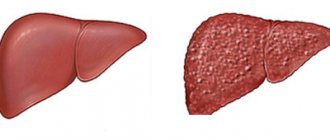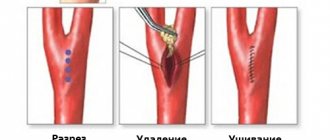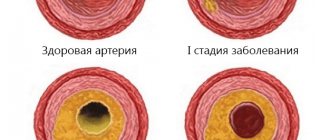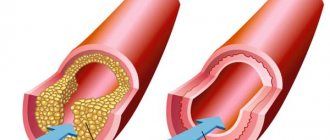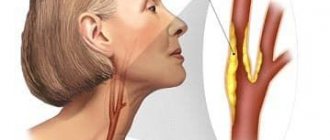Atherosclerosis
is a chronic disease characterized primarily by damage to medium and large arteries. On the inner walls of the arteries, fat deposits form in the form of atherosclerotic plaques, which can grow and block the lumen of the arteries - first partially, and in advanced cases, completely. As a result, the blood supply to the organs to which the artery leads is disrupted. The consequences of atherosclerosis are very serious and can be life-threatening. Atherosclerosis is the cause of coronary heart disease, heart attacks and strokes, and gangrene.
Causes
In most cases, vascular stenosis is caused by the presence of atherosclerotic plaques on their walls. A chronic vascular disease such as atherosclerosis gradually affects large arteries. Cholesterol is an element present in the blood of every person. Any of us is susceptible to a disease such as atherosclerosis, and vascular stenosis as its consequence. Provoking factors in this case are bad habits (smoking, alcohol), poor diet, sedentary lifestyle, and old age. Diabetes mellitus can also aggravate arterial stenosis.
Cholesterol deposited on the vascular walls hardens and turns into dense plaques. If they block the lumen of the vessel, we are talking about stenosing atherosclerosis. Fragments of atheromatous plaques can separate and form blood clots, which leads to complete blockage of blood vessels. In addition, atherosclerosis weakens the walls, as a result of which they delaminate and aneurysms form on them - a vascular pathology, which you can learn about in detail here.
Symptoms
Depending on which vessels are affected, the symptoms of arterial stenosis vary.
- If stenotic processes occur in the vessels of the heart, exertional angina appears - we wrote about its functional classes earlier. The reason to seek emergency help in this case may be a prolonged attack (more than 15 minutes), which does not stop at rest or when taking the usual dose of nitroglycerin. Such signs usually indicate acute coronary syndrome.
- Stenosis of the vessels responsible for the blood supply to the brain is no less dangerous, as it can lead to cerebral infarction or stroke. Carotid artery stenosis is a dangerous phenomenon, the consequence of which is often fatal.
- Stenoses can also occur in peripheral vessels, including the arteries of the lower extremities. Common symptoms of atherosclerosis of the lower extremities are pain in the legs when walking or at rest, periodic lameness, and discoloration of the skin. Stenotic processes in this vascular bed lead to ischemia of the lower extremities, which in the absence of timely treatment can lead to disability.
Signs of cerebral vasoconstriction
There can be many reasons for the narrowing of blood vessels in the brain. But, you should pay attention specifically to the forms of the already established disease: initial and chronic. It is difficult to judge which of them is most dangerous for the human body. Because the chronic form can plague a person for years, and the initial form can lead to death at the very first stage.
That is why it is so important not to miss the first “bells” of the onset of the disease.
So, the following signs should alert you:
- functional disorders of the central nervous system (fatigue, migraines, unexplained irritability, tearfulness, overexcitation, touchiness);
- incipient memory problems (short-term forgetfulness, inability to remember what happened a few minutes ago - the name of the program, the location of the keys, etc.);
- change in gait (a person shuffles his feet or minces heavily);
- the appearance of a false urge to urinate;
- loss of coordination of movements, loss of balance;
- development of dementia;
- malfunctions in the functioning of internal organs located in the pelvic area.
Treatment
First of all, when treating vascular stenosis, it is necessary to follow a diet, increase physical activity and give up bad habits. In addition, the patient is prescribed medications to dilate blood vessels, accelerate blood flow, and lower cholesterol levels. In some cases, surgery is recommended.
Stenting can quickly and effectively restore blood flow and eliminate stenosis. This is one of the most modern methods of treating vascular diseases accompanied by impaired arterial patency. It is characterized by minimal trauma to the patient. In this case, the effect on the vessel is carried out from the inside, using a special catheter inserted through a micropuncture into the artery. The essence of such operations as stenting of the carotid arteries, heart vessels or limbs is that an endoprosthesis (stent) is installed at the site of narrowing, which acts as a frame and holds the vascular walls. These operations are the safest and give the best results.
Vascular diseases: signs and treatment
22.10.2019
How can you help your blood vessels be healthy? What diseases are there that are common lately? The answer to this question is in this article.
A person lives and does not notice how his arteries and veins throughout the body help to supply nutrients and oxygen to the organs. Vascular diseases in our time, unfortunately, are one of the main causes of mortality. More often these problems occur in children and adolescents.
What diseases do blood vessels have?
Doctors divide types of vascular diseases according to their location; they find the source of the disease. If the central nervous system , then this disrupts blood circulation in the aortas and arteries of various parts of the body. Symptoms of different ailments may be different.
Atherosclerosis
This dangerous disease is quite insidious. Its main cause is “bad” cholesterol. It accumulates in the body with increasing consumption of junk food. Lead to atherosclerosis : diabetes , hypertension , obesity , bad heredity, bad habits.
Symptoms may vary. If we are talking about heart , then pain is usually noticeable in the left side of the chest , radiating to the arm. heart rhythm disturbances , weakness in the legs and arms, and possible fainting. With atherosclerosis dizziness and a burning sensation in the chest occur . If the abdominal region suffers, then problems appear with the gastrointestinal tract, kidneys abdominal pain . There are of atherosclerosis .
Ischemia
This disease occurs when there is insufficient blood in certain vessels that supply the myocardium and brain . Excessive exercise and stress can be its cause. In any case, it disrupts the body's carbohydrate-fat metabolism.
If a person has chest pain radiating to the arm, shortness of breath, arrhythmia, rapid pulse - this may be an indicator of ischemic diseases.
Strokes
A most insidious illness that has often appeared in people lately. Occurs from impaired blood supply to brain . In the process, nerve endings may die and their functions may deteriorate. At first, the symptoms are not noticeable. But if you have weakness and numbness in your arms and legs , as well as a throbbing headache, possible double vision and nausea your doctor immediately .
Hypertension
It seems something normal and not so scary. But symptoms such as pain in the back of the head, in the temples, tinnitus and dark spots before the eyes , dizziness , swelling of the limbs and nausea doctor about your condition . Otherwise hypertension , hypertension can lead to complicated diseases.
VSD
The development of VSD - vegetative-vascular dystonia - is observed when there is a malfunction in the functioning of the nervous system and weakening of blood vessels. insomnia can lead to this - all this is the cause of this disease.
Varicose veins
This is also not such a simple, although common, ailment. It is noticeable when venous patterns appear on the legs , but begins much earlier. If a person has bad heredity, he leads an incorrect lifestyle - all this can affect the blood vessels of the legs . Venotonics and compression garments can help, but this cannot be done without the advice of a doctor .
Diagnostics related to blood vessels
Once again it is worth recalling that only a doctor . An ordinary person may not understand the course of a particular disease and may prescribe the wrong and sometimes harmful medications to himself.
If you see a doctor , he will most likely prescribe a clinical blood . In some cases, biochemical and immunological tests, coagulogram, vascular angiography, ultrasound , MRI or RVG of vessels are also indicated.
It must be remembered that possible complications from vascular diseases are common and unpleasant, so consult a good doctor .
Remedies against vascular diseases
To treat vascular diseases, doctors use various drugs: myotropic and neurotropic drugs, blockers, cardiac drugs, drugs with nicotinic acid and others. But doctors remind: you need to eat right. To do this, you need to prepare dishes from cereals , bran, vegetable oils (especially olive), sea fish and seafood. Biscuits, bread, light vegetable or meat soups, nuts, legumes, seasonal berries and fruits are also useful. Doctors ask you to pay attention to the fact that you need to eat seasonal vegetables and fruits.
You also need to manage stress, regularly measure your blood pressure, take walks, have a hobby, do yoga and Pilates.
Published in Cardiology Premium Clinic
